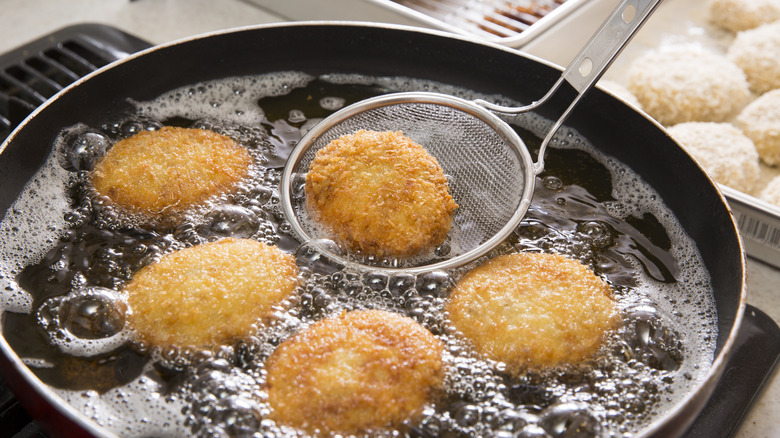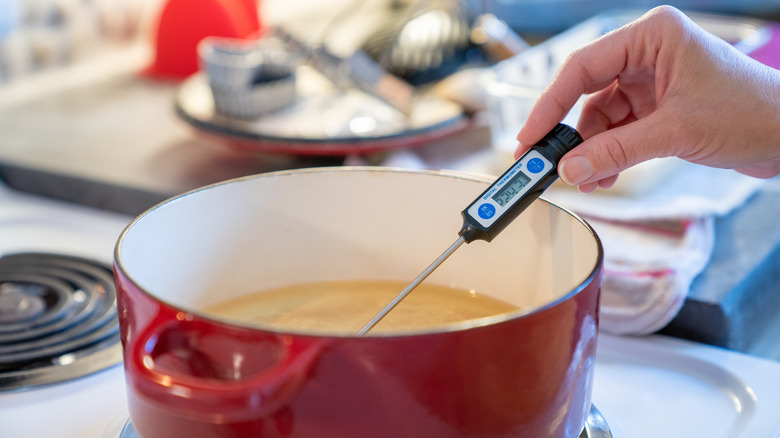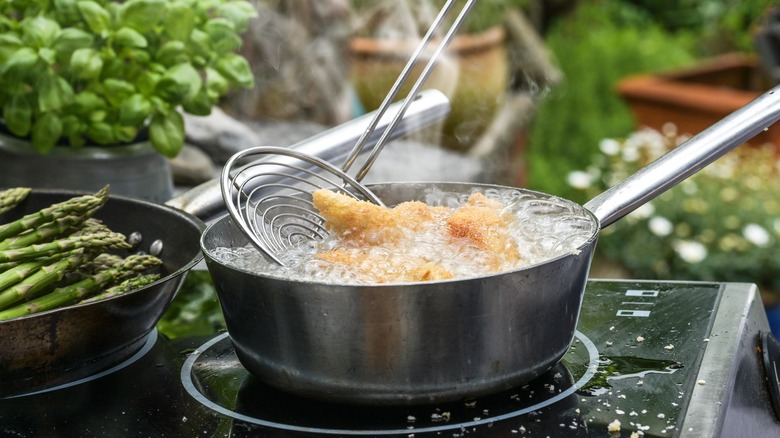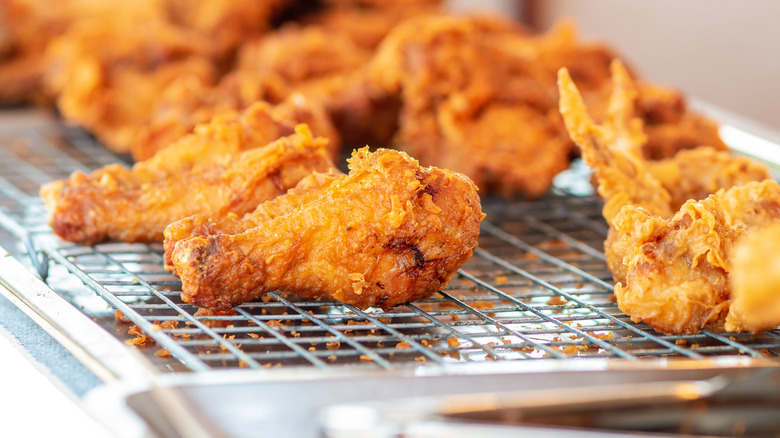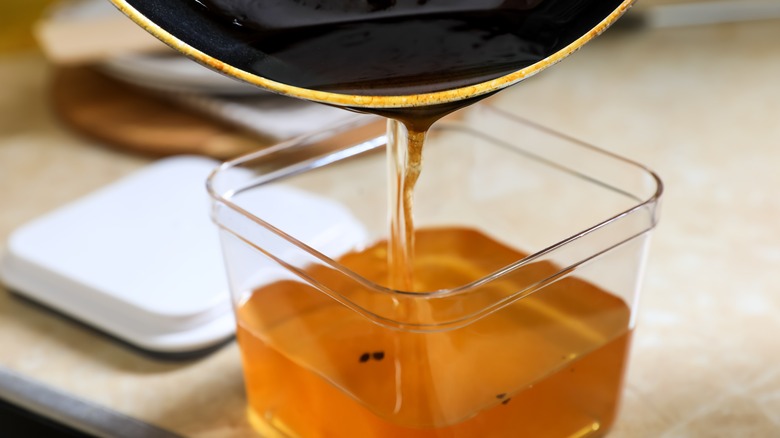The Essential Kitchen Tools You Need For Foolproof Deep-Frying At Home
We may receive a commission on purchases made from links.
The air fryer is America's favorite kitchen appliance — and you know we love an easy air-fried recipe — but sometimes, there's just no way an air fryer can completely replicate the golden, crispy perfection achieved when something like onion rings or yeasted doughnuts come to life in a boiling bath of hot oil. Whether you want to deep fry a whole chicken or recreate the McDonald's deep fried apple pie, there are some circumstances where deep frying is a non-negotiable. But unfortunately, embarking on a deep-frying journey in your own home can be quite an undertaking that intimidates many home cooks.
Unlike professional kitchens, most of us don't have large appliances manufactured solely for the purpose of fully submerging food in bubbling oil to cook it, nor are our home kitchens made out of easy-to-clean stainless steel nor include a team of people to help clean it. The truth is, most of us are destined to make somewhat of a mess when attempting to deep fry at home, as well as put ourselves at risk of harm as large quantities of hot oil can be very dangerous. With the right tools, however, deep frying at home can be foolproof, less messy, and dare we say, even enjoyable. You'll need a deep pot, a thermometer, a spider or slotted spoon, a baking tray, a cooling rack, and a storage container. Let's dig deeper into each tool.
A deep pot and thermometer make working with hot oil safer
The first thing you'll need (other than oil and food to fry of course) is a large, deep pot with handles. Ideally, you should be deep frying in a dutch oven, but any sturdy, heavy-bottomed pan with high walls will suffice. Dutch ovens are workhorses in the kitchen and are great for so many uses, and they're excellent for deep frying with their sturdy handles and high, thick walls. Plus, they're usually made from materials that conduct and hold heat well, like cast iron or ceramic. The high walls are a safety feature as well, making the chances of oil bubbling over the edges and hitting the flame much less likely, which is usually the cause of fires when deep frying.
To make sure your oil doesn't get too hot nor too cold, a deep fry thermometer or a candy thermometer are essential as they can help you maintain and regulate the temperature of the oil, which should remain as steady as possible. Whether it's digital or analog, the important feature of any thermometer used for deep frying is that it can clip onto the side of the pot and remain hovering in the oil, not touching the bottom of the pot, as that would skew the temperature reading. The thermometer's ability to clip on to the wall of the pot leaves your hands free to tackle the rest of the elements of deep frying and allows you to focus on the task at hand without having to constantly check the oil temperature manually.
The right tools for turning and removal make all the difference
After you've started heating the oil in your dutch oven and clipped a thermometer onto the side, it's time to assemble the rest of your tools. A spider or a large slotted spoon are essential to frying. A spider, not to be confused with the creepy crawly arachnid, is a perfect tool for lowering delicate items into the frying oil as the foods can rest on the relatively flat area of the spider, then release into the oil to float. A spider — like this Walfos spider on Amazon — is also a great tool for gently turning over items that need to be flipped and browned evenly on the opposite side. While a spider might seem like a niche kitchen tool, you can use it in other ways, like straining pasta when you don't have a colander, and it's especially perfect for fragile, larger pastas like tortellini or stuffed ravioli.
If you're deep frying foods that are more sturdy, light metal tongs are also a great tool to use. Tongs are perfect for picking up food and gently placing it into the hot oil, as opposed to using your hands and risking the oil burning your fingers. Tongs are also helpful for turning heftier items like fried chicken, ensuring that all sides of the food cook evenly. While there are many types of tongs, the best choice for frying is a longer, lightweight utility tong.
Create a safe landing pad for fried foods
Sheet pans have a higher edge on all sides and are not interchangeable with cookie sheets. They come in multiple sizes and are ideal for many kitchen uses outside of deep frying, especially half- and quarter-sheet sizes. Since sheet pans come in many sizes, be sure that the size of your wire rack is compatible with your sheet pan; it should fit perfectly in the sheet pan.
Wire racks are an essential part of deep frying. Imagine putting in all of that work to achieve crisp, craggily edges only to have them get sad and soggy while resting in their own oil drippings while they cool and rest. Thankfully, a wire rack is an easy solution to keep fried foods crunchy as it suspends the food in midair and allows any remaining oil to drip off. For easier cleanup, place a layer of paper towels between the sheet pan and the wire rack to catch excess oil drippings.
Set yourself up for frying success by getting everything in position before you begin the actual frying. Place the raw food on one side of the dutch oven, and set the sheet pan with the wire rack inside it on the other side. Keep the rack far enough from the flames but close enough to use as a landing spot for the fried items. While not a kitchen tool, have easily accessible salt next to the wire rack landing pad so that you can salt the food as it comes out of the fryer, as is needed for most savory fried foods.
Wrap everything up after frying
Another essential item for deep frying raw foods is an instant-read thermometer, like this digital ThermoPro model on Amazon. This kitchen tool helps you ensure that foods are fully cooked to their proper temperature. For example, if you pull a piece of fried chicken from the pot, but the thermometer reads 150 degrees Fahrenheit, you know right away that it's not cooked to safety standards and can return it to the oil to finish cooking properly. An instant-read thermometer will serve so many uses in your kitchen other than just deep frying; it will help do everything from cook steak to the perfect doneness to helping gauge if your warm water is the right temperature for activating yeast in your next baking project.
After you've enjoyed the deep-fried deliciousness, and the oil has fully cooled, you may be able to save the oil if it's still fairly clean and there isn't too much floating around from anything battered or breaded. Check out our guidelines to see if you can reuse your frying oil before throwing yours away. If it's good to reuse, use a fine mesh strainer lined with a paper towel or cheesecloth to strain out any debris from the cooled oil before storing in a dark, cool cabinet or in the refrigerator. Save and reuse this oil for future deep frying now that you have the confidence and the essential kitchen tools to become a deep frying professional.
